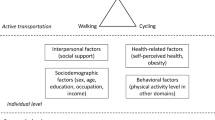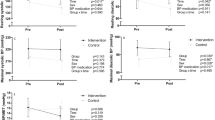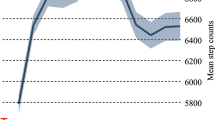Abstract
Background:
Abdominally obese women can reduce their health risk through regular physical activity. There is, however, little evidence on the effectiveness of interventions that promote physical activity long-term, such as cycling and walking to and from work.
Methods:
This intervention focused on physically active commuting (cycling and walking) in middle-aged (30–60 years), abdominally obese (waist circumference ⩾88 cm) women (n=120), recruited by newspaper advertisement. The intervention group was a moderate-intensity programme with physician meetings, physical activity prescriptions, group counselling and bicycles. The control group was a low-intensity group support programme with pedometers. We used a randomized, controlled, 2-armed design with 18 months duration and intention-to-treat analysis (data collection 2005–2006). Treatment success was defined as bicycling ⩾2 km/d (primary) or walking 10 000 steps per day (secondary).
Results:
At baseline, mean (s.d.) age was 48.2 years (7.4), waist circumference 103.8 cm (7.8), walking 8471 steps per day (2646), bicycling 0 km per day. Attrition at 18 months was 10% for the intervention group and 25% in the control group (P=0.03). The intervention group was more likely to achieve treatment success for cycling than controls: 38.7 vs 8.9% (odds ratio (OR)=7.8 (95% confidence interval=4.0 to 15.0, P<0.001)), but with no difference for compliance with the walking recommendation: 45.7 vs 39.3% (OR=1.2 (95% CI=0.7 to 2.0, P=0.50)). Commuting by car and public transport were reduced by 34% (P<0.01) and 37% (P<0.001), respectively, with no differences between groups. Both groups attained similar waist reductions (−2.1 and −2.6 cm, P=0.72).
Conclusions:
Abdominally obese women can increase PA long-term through moderate-intensity behavioural support aimed at changing commuting habits.
This is a preview of subscription content, access via your institution
Access options
Subscribe to this journal
Receive 12 print issues and online access
$259.00 per year
only $21.58 per issue
Buy this article
- Purchase on Springer Link
- Instant access to full article PDF
Prices may be subject to local taxes which are calculated during checkout




Similar content being viewed by others
References
Haskell WL, Lee IM, Pate RR, Powell KE, Blair SN, Franklin BA et al. Physical activity and public health: updated recommendation for adults from the American College of Sports Medicine and the American Heart Association. Circulation 2007; 116: 1081–1093.
Ross R, Dagnone D, Jones PJ, Smith H, Paddags A, Hudson R et al. Reduction in obesity and related comorbid conditions after diet-induced weight loss or exercise-induced weight loss in men. A randomized, controlled trial. Ann Intern Med 2000; 133: 92–103.
Ross R, Janssen I, Dawson J, Kungl AM, Kuk JL, Wong SL et al. Exercise-induced reduction in obesity and insulin resistance in women: a randomized controlled trial. Obes Res 2004; 12: 789–798.
Blair SN, Church TS . The fitness, obesity, and health equation: is physical activity the common denominator? JAMA 2004; 292: 1232–1234.
Hamer M, Chida Y . Active commuting and cardiovascular risk: a meta-analytic review. Prev Med 2008; 46: 9–13.
Bassett Jr DR, Pucher J, Buehler R, Thompson DL, Crouter SE . Walking, Cycling, and Obesity Rates in Europe, North America, and Australia. J Phys Act Health 2008; 5: 795–814.
Shephard RJ . Is active commuting the answer to population health? Sports Med 2008; 38: 751–758.
Andersen LB, Schnohr P, Schroll M, Hein HO . All-cause mortality associated with physical activity during leisure time, work, sports, and cycling to work. Arch Intern Med 2000; 160: 1621–1628.
Matthews CE, Jurj AL, Shu XO, Li HL, Yang G, Li Q et al. Influence of exercise, walking, cycling, and overall nonexercise physical activity on mortality in Chinese women. Am J Epidemiol 2007; 165: 1343–1350.
Araiza P, Hewes H, Gashetewa C, Vella CA, Burge MR . Efficacy of a pedometer-based physical activity program on parameters of diabetes control in type 2 diabetes mellitus. Metabolism 2006; 55: 1382–1387.
Hemmingsson E, Hellenius ML, Ekelund U, Bergstrom J, Rossner S . Impact of social support intensity on walking in the severely obese: a randomized clinical trial. Obesity (Silver Spring) 2008; 16: 1308–1313.
Tudor-Locke C, Bell RC, Myers AM, Harris SB, Ecclestone NA, Lauzon N et al. Controlled outcome evaluation of the First Step Program: a daily physical activity intervention for individuals with type II diabetes. Int J Obes Relat Metab Disord 2004; 28: 113–119.
Yamanouchi K, Shinozaki T, Chikada K, Nishikawa T, Ito K, Shimizu S et al. Daily walking combined with diet therapy is a useful means for obese NIDDM patients not only to reduce body weight but also to improve insulin sensitivity. Diabetes Care 1995; 18: 775–778.
Ogilvie D, Egan M, Hamilton V, Petticrew M . Promoting walking and cycling as an alternative to using cars: systematic review. BMJ 2004; 329: 763.
Ogilvie D, Foster CE, Rothnie H, Cavill N, Hamilton V, Fitzsimons CF et al. Interventions to promote walking: systematic review. BMJ 2007; 334: 1204.
Dunn AL, Marcus BH, Kampert JB, Garcia ME, Kohl III HW, Blair SN . Comparison of lifestyle and structured interventions to increase physical activity and cardiorespiratory fitness: a randomized trial. JAMA 1999; 281: 327–334.
Prochaska JO, Velicer WF, Rossi JS, Goldstein MG, Marcus BH, Rakowski W et al. Stages of change and decisional balance for 12 problem behaviors. Health Psychol 1994; 13: 39–46.
Tudor-Locke C, Bassett Jr DR . How many steps/day are enough? Preliminary pedometer indices for public health. Sports Med 2004; 34: 1–8.
Schneider PL, Crouter SE, Bassett DR . Pedometer measures of free-living physical activity: comparison of 13 models. Med Sci Sports Exerc 2004; 36: 331–335.
Hill JO, Wyatt HR, Reed GW, Peters JC . Obesity and the environment: where do we go from here? Science 2003; 299: 853–855.
Saelensminde K . Cost–benefit analyses of walking and cycling track networks taking into account insecurity, health effects and external costs of motorized traffic. Transportation Research Part A: Policy and Practice 2004; 38: 593–606.
Lee SA, Xu WH, Zheng W, Li H, Ya Ng G, Xiang YB et al. Physical activity patterns and their correlates among Chinese men in Shanghai. Med Sci Sports Exerc 2007; 39: 1700–1707.
Ainsworth BE, Haskell WL, Whitt MC, Irwin ML, Swartz AM, Strath SJ et al. Compendium of physical activities: an update of activity codes and MET intensities. Med Sci Sports Exerc 2000; 32 (9 Suppl): S498–S504.
Lee CD, Blair SN, Jackson AS . Cardiorespiratory fitness, body composition, and all-cause and cardiovascular disease mortality in men. Am J Clin Nutr 1999; 69: 373–380.
Veisten K, Saelensminde K, Alvaer K, Bjornskau T, Elvik R, Schistad T et al. Total costs of bicycle injuries in Norway: Correcting injury figures and indicating data needs. Accid Anal Prev 2007; 39: 1162–1169.
Rothman KJ, Michels KB . The continuing unethical use of placebo controls. N Engl J Med 1994; 331: 394–398.
Lichtman SW, Pisarska K, Berman ER, Pestone M, Dowling H, Offenbacher E et al. Discrepancy between self-reported and actual caloric intake and exercise in obese subjects. N Engl J Med 1992; 327: 1893–1898.
Fogelholm M, Kukkonen-Harjula K, Nenonen A, Pasanen M . Effects of walking training on weight maintenance after a very-low-energy diet in premenopausal obese women: a randomized controlled trial. Arch Intern Med 2000; 160: 2177–2184.
Acknowledgements
The study was supported by a grant from Cycleurope Inc., a bicycle retailer. Cycleurope also provided logistical support for the intervention group (bicycles, helmets and bicycle service). Cycleurope had no role in the design or conduct of the study; the collection, management, analysis and data interpretation; or the preparation, review or approval of the article. This study would not have been possible without the outstanding efforts of our research nurse, Birgitta Spetz. Our final thanks go to our participants.
Author information
Authors and Affiliations
Corresponding author
Rights and permissions
About this article
Cite this article
Hemmingsson, E., Uddén, J., Neovius, M. et al. Increased physical activity in abdominally obese women through support for changed commuting habits: a randomized clinical trial. Int J Obes 33, 645–652 (2009). https://doi.org/10.1038/ijo.2009.77
Received:
Revised:
Accepted:
Published:
Issue Date:
DOI: https://doi.org/10.1038/ijo.2009.77
Keywords
This article is cited by
-
InterMob: a 24-month randomised controlled trial comparing the effectiveness of an intervention including behavioural change techniques and free transport versus an intervention including air pollution awareness-raising on car use reduction among regular car users living in Grenoble, France
BMC Public Health (2022)
-
Effects of active commuting and leisure-time exercise on fat loss in women and men with overweight and obesity: a randomized controlled trial
International Journal of Obesity (2018)
-
The Exercising Commuter: Is Commuting a Healthy Way to Be Active?
Current Cardiovascular Risk Reports (2012)



